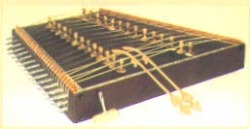Santur

The eighty seven-stringed instrument believed to have evolved from the hundred-stringed lute (shata-tantri vina) of the Vedas! However, the classical santur has evolved from the Kashmiri santur, and the latter was indeed a hundred-stringed instrument. The santur form can also be seen in the folk instruments of Russia and Eastern Europe.
The present-day classical instrument is a trapezoidal box, with a resonance chamber that emits sound through the circular opening at its narrow end. The eighty seven metal strings are placed parallel across the box, in twenty nine sets of three strings each. An arrangement of pegs on the box surface holds each set alternately from the left or the right side. There is thus a rise and dip of the strings depending on the placement of the peg. Further, there rows of nails on the left 'wall' of the box serve to fix the strings, with corresponding tuning peg holes on the right 'wall' of the box.
The three strings of each set are tuned to the same note. The first set (close to the base) is tuned to kharaj shadja (the note shadja in the lowest register). Hence, the first twelve sets are tuned to twelve notes in the lowest register, the next twelve sets are tuned to twelve notes in the middle register with the last string of this lot tuned to komal gandhara in the highest register.
Ragas are played by striking the strings with wooden strikers. Altering the strength and angle of the stroke creates a variety of sounds, and the patterns and emphasis all make for compositions not unlike those of the gats of sitar and sarod playing. Notes are not long-lived, and only shadow and grace notes can be elicited from the santur, apart of course from the fixed notes of each set. The midh ornament is impossible on the santur, and many musicians have resorted to various techniques, but all to no avail.
Nonetheless, the musical range of the santur is vast, and sitar features like alap, jod and jhala can be played on this instrument. Ragas like Gorakh-Kalyan and certain t?s - rupak, matta - t?, and jhap-t?-lend themselves to the santur playing range.
Renowned santur player: Pandit Shiv Kumar Sharma.
